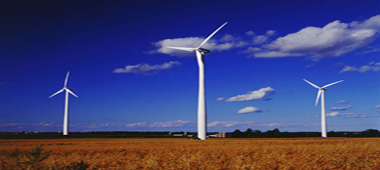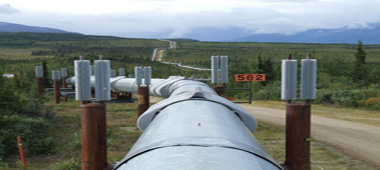Nuclear fission
Power Generation by nuclear fission
Nuclear fission is an energy source that requires both the mastery of technology and responsible policies to unfold its huge potential in a sustainable energy mix. At this point in time it is probably the most suitable candidate to provide cheap and clean base load where cooperation between industry, science and policy makers can succeed to create a suitable environment.
Power generation by nuclear fission utilizes energy released directly from the atomic nucleus, very much like nuclear fusion. This nucleus consists of nucleons - neutrons and protons, where neutrons have no electrical charge at all, and protons carry a positive charge. In this respect, any nucleus with more than one proton would be unstable and fall apart because of the repulsion of equal electrical charges. This repulsive force is mainly countered by strong interaction, one of the four fundamental forces in physics.

Depending on the composition of the nucleus, the relationship between neutrons and protons sets the contribution of these forces. This determines how strong the nucleus is bound, which results in the quantity “average binding energy per nucleon” of a nucleus which is the crucial value for power production by nuclear fission. It is at its strongest for iron and gets less mobile in both directions, towards lighter and heavier elements. The trick therefore is simple: if you look at a heavy element, you have a certain average binding energy per nucleon and a certain number of nucleons in the nucleus associated with this energy. This sums to the total binding energy of the nucleus. If you split this nucleus into two nuclei, which are lighter and closer to iron, you have the same number of nucleons as before, but with higher average binding energy. If one now considers that binding energy is negative, and the famous fact that E=mc², you end up with the conclusion that the total summed weight of the two new nuclei is less than that of the original nucleus. This might be a bit surprising but that‘s the way nature works – this phenomenon is called mass defect. It is exactly this “missing” mass that is unleashed during the splitting reaction and is then used to heat a coolant and produce electricity in nuclear power plants.
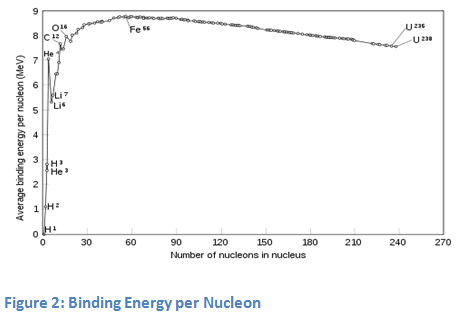
As one can now easily see, nuclear fission power production relies on the same effect as nuclear fusion, except in different directions. Since it is tough to understand the opportunities and challenges of nuclear fission, it is important to know how this nuclear reaction is triggered.
Nuclear energy is produced by holding up the described effect within a self-sustained chain reaction. A neutron is used to split the nucleus of a fuel atom, typically Uranium. This process produces two daughter nuclei and some more free neutrons – which again collide with fuel, triggering the same reaction. Where uranium itself is only slightly radioactive, the elements created during this reaction are far more active. While you can stand directly next to a fresh uranium fuel element without any undesirable effects, a used fuel element is hazardous. To safely operate the power plant, it is necessary to control the rate of neutrons newly generated by fissions which will again trigger new fissions. Too few neutrons would mean a breakdown of the chain reaction; too many would result in an avalanche-reaction also called over criticality. Criticality is used as term for the state of exact equilibrium, where the same number of neutrons is consumed and produced. This is achieved by the control rods, mechanical adjustable installations that absorb neutrons and therefore allow the operators to control the criticality.
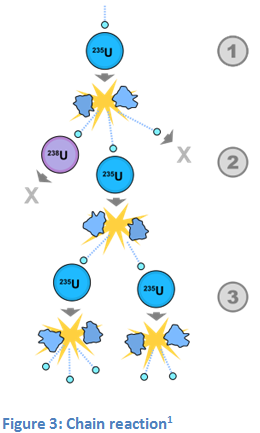
A Nuclear power plant consists of a reactor, housing the core, which consists of fuel and instrumentation including the mentioned control rods. At the end of the day this very delicate nuclear reaction following the complex laws of theoretic physics is simply used to heat a coolant. This, like in any other caloric power plant is used to feed a turbine linked to a generator. We see, apart from the way the coolant is heated, a nuclear power plant is designed very much like other power plants.
A crucial feature in nuclear power plants is safety, which in this context mainly means separating the highly radioactive material produced during the nuclear processes from the environment. This is achieved by multiple barriers between the nuclear material and the environment. Aside from outside influences like earthquakes and floods, two major effects have to be taken into account to keep these barriers intact.
Firstly criticality must be under full control; an uncontrolled growth of the neutron population would cause the mentioned avalanche like reaction and destroy the barriers holding back the nuclear material. This is achieved in several ways, mainly by the control rods but also by composition of materials used in the core. Besides other active safety features, they can passively achieve an immediate breakdown of chain reaction if the system parameters fluctuate from normal.
Secondly the decay heat produced by the core must be dealt with. During power production the heat generated by the fuel is needed for power production, but it does not stop right away after the chain reaction is stopped. During operation the neutrons of the chain reaction generate lots of different radioactive nuclei within the fuel. They have the potential to release energy - but they don’t do it immediately. So even if the reactor is shut down it must be cooled for some time, otherwise the fuel elements will heat up to a level where they melt down and also might damage the barriers. For common types of large scale commercial reactors it takes about three days of cooling until the coolant has reached a temperature to consider the power plant in cold shutdown condition.
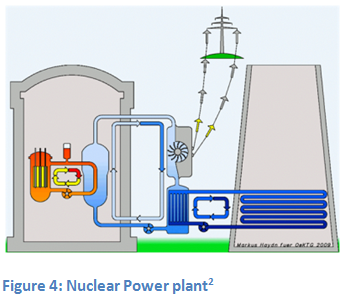
Also the spent fuel which is highly radioactive is an issue. The waste is hazardous and stays hazardous for a long time. Waste treatment is very complex and is a strongly discussed field. Physically it is possible to treat the waste in a way in which it can be reused as fuel or by making it “lose” its radioactivity considerably quickly. Although these processes can already effectively reduce the waste, the more sophisticated solutions are far away from being available at industrial scale to competitive prices.
Until now safe storage of the waste must be granted, which is done in a geological final deposit. Financially speaking operators of nuclear power plants need to invest about 10% of their profit into final waste storage and decommissioning of the plant.
In general, the financial attributes of a nuclear power plant are high investment costs and low operation costs. The share price of fuel consumption in nuclear generated power is as low as 5-6%. It is able to deliver steady base load with refueling and maintenance outages of typically one to three weeks a year. The CO2 emission values are very much competitive with renewable energy sources since all emissions fall to the production of the fuel and the plant itself, as good as no CO2is produced during operation. Fuel can be uranium, thorium or plutonium and contrary to common believe amongst many environmentalists, is available in considerable amounts and will not be the limiting factor for nuclear power.
Michael Gerstmayr


